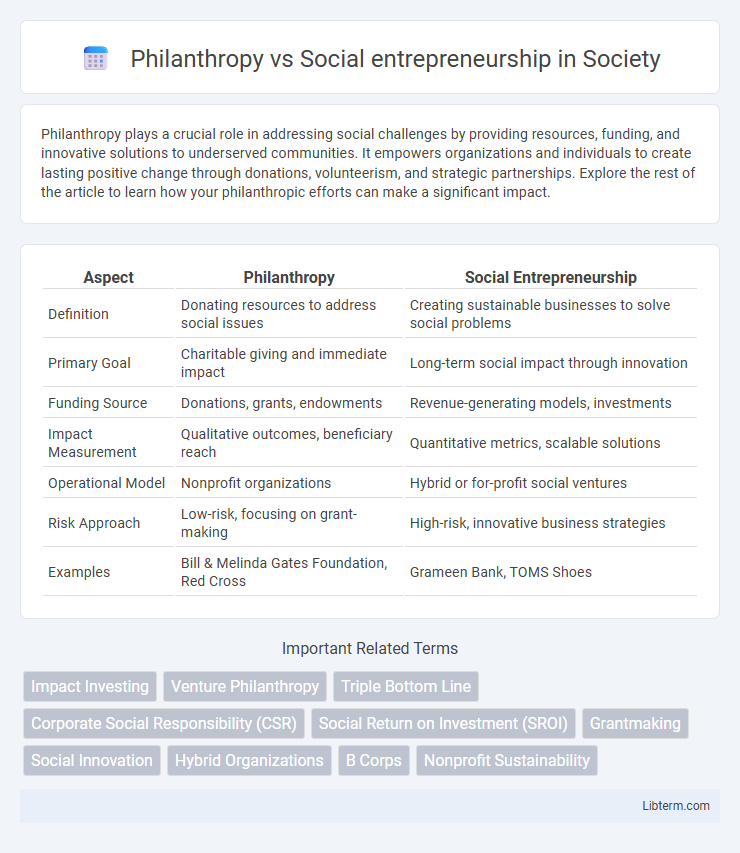Philanthropy plays a crucial role in addressing social challenges by providing resources, funding, and innovative solutions to underserved communities. It empowers organizations and individuals to create lasting positive change through donations, volunteerism, and strategic partnerships. Explore the rest of the article to learn how your philanthropic efforts can make a significant impact.
Table of Comparison
| Aspect | Philanthropy | Social Entrepreneurship |
|---|---|---|
| Definition | Donating resources to address social issues | Creating sustainable businesses to solve social problems |
| Primary Goal | Charitable giving and immediate impact | Long-term social impact through innovation |
| Funding Source | Donations, grants, endowments | Revenue-generating models, investments |
| Impact Measurement | Qualitative outcomes, beneficiary reach | Quantitative metrics, scalable solutions |
| Operational Model | Nonprofit organizations | Hybrid or for-profit social ventures |
| Risk Approach | Low-risk, focusing on grant-making | High-risk, innovative business strategies |
| Examples | Bill & Melinda Gates Foundation, Red Cross | Grameen Bank, TOMS Shoes |
Defining Philanthropy and Social Entrepreneurship
Philanthropy involves donating resources such as money, time, or expertise to support charitable causes without expecting financial returns, primarily aimed at alleviating social issues. Social entrepreneurship creates sustainable ventures that address social problems through innovative business solutions while generating revenue to maintain impact. Both approaches seek positive societal change, but philanthropy relies on generosity, whereas social entrepreneurship emphasizes market-driven innovation.
Historical Evolution of Giving and Social Innovation
Philanthropy has historically centered on charitable giving and altruistic donations primarily aimed at addressing immediate social needs, tracing back to ancient civilizations and religious traditions. Social entrepreneurship emerged more recently as an innovative approach that combines business principles with social impact goals to create sustainable solutions addressing systemic problems. This evolution reflects a shift from direct aid to strategic, market-driven interventions designed to empower communities and generate long-term social change.
Core Objectives: Charitable Aid vs Sustainable Impact
Philanthropy primarily focuses on charitable aid, aiming to provide immediate relief and support to vulnerable populations through donations and grants. Social entrepreneurship targets sustainable impact by developing innovative business models that address social issues while generating financial self-sufficiency. Both approaches contribute to societal improvement, but social entrepreneurship emphasizes long-term solutions and systemic change over short-term assistance.
Funding Models: Donations versus Investments
Philanthropy primarily relies on donations, where funds are given without the expectation of financial return, focusing on charitable causes and immediate social impact. Social entrepreneurship employs investment-based funding models, attracting capital that anticipates both social impact and financial returns through sustainable business ventures. This fundamental difference in funding models influences operational strategies, scalability, and long-term sustainability outcomes for each approach.
Measuring Social Impact and Success
Philanthropy measures social impact primarily through grant outcomes, focusing on short-term benefits and qualitative assessments like beneficiary feedback and case studies. Social entrepreneurship employs data-driven metrics, including social return on investment (SROI) and scalable impact models, to evaluate long-term, sustainable success and system-level changes. Combining quantitative indicators with qualitative narratives allows both approaches to refine strategies and enhance community transformation.
Key Challenges in Philanthropy and Social Entrepreneurship
Philanthropy faces challenges such as reliance on donor funding, limited scalability, and difficulty measuring long-term impact. Social entrepreneurship often struggles with balancing financial sustainability and social mission while navigating regulatory hurdles and market competition. Both sectors require innovative approaches to enhance accountability, stakeholder engagement, and effective resource allocation.
Role of Stakeholders and Community Engagement
Philanthropy primarily relies on donors and charitable organizations to drive funding, with limited direct involvement from beneficiaries and community members in decision-making processes. Social entrepreneurship actively engages diverse stakeholders, including customers, employees, and local communities, fostering collaborative solutions that address social issues sustainably. This inclusive approach enhances community empowerment, accountability, and long-term impact compared to traditional philanthropy.
Real-World Examples and Case Studies
Philanthropy often involves donations and grants aimed at addressing social issues, exemplified by the Bill & Melinda Gates Foundation's efforts to eradicate diseases through funding and support. Social entrepreneurship, as demonstrated by companies like TOMS Shoes, integrates social missions directly into business models by providing products or services that solve community challenges while maintaining profitability. Real-world case studies reveal that philanthropy tends to focus on short-term aid, whereas social entrepreneurship drives sustainable change by blending innovation with market-based solutions.
Future Trends: Blurring the Boundaries
Philanthropy and social entrepreneurship increasingly overlap as future trends emphasize hybrid models combining charitable giving with sustainable business solutions. The rise of impact investing and corporate social responsibility enhances collaborative efforts, fostering innovation in addressing social challenges. This blurring of boundaries promotes scalable, measurable social impact driven by both nonprofit and for-profit sectors.
Choosing the Right Approach for Social Change
Philanthropy typically involves donating money or resources without direct involvement in operational activities, aiming for immediate relief or support, while social entrepreneurship creates sustainable business models that address social issues through innovation and market-based solutions. Choosing the right approach depends on the desired impact timeframe and scalability, where philanthropy suits urgent needs and social entrepreneurship drives long-term change. Analyzing factors such as resource availability, community engagement, and measurable outcomes helps determine the optimal strategy for effective social transformation.
Philanthropy Infographic

 libterm.com
libterm.com